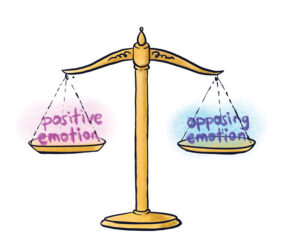Paradox & Problem Statements
The Power of Paradox
Now that we have a draft purpose statement that scores at least an eight or above we can move onto the next critical phase . . . Paradox! Working through paradoxes and tensions to make decisions is the most critical role for a leader and a leadership team.
This next section will help manage the differences and align on the agreements. Then you can make progress faster together toward your desired outcomes.
How are we defining Paradox and what does it have to do with our purpose statement?
It is common for each team member to have different ideas and approaches. Inherent tensions exist when there are differences. This process focuses on seeing all the different dimensions together to help explore, understand, and decide how to proceed.
When most people use the word paradox, they mean holding onto opposing situations at the same time. The way we use paradox is slightly different . . .
We add opposing emotions into the mix. Why?
The ability to name our emotions facilitates access to a powerful part of the brain . . . It enables us to better articulate a problem or opportunity with greater clarity and specificity.
We simply use emotions to help guide us.

And, by the way, if it doesn’t help you, Don’t worry. Paradoxical thinking is natural for only about 1/3 of us!
Pro Tip: Exploring opposing emotions creates better results, increased trust, and credibility.
Here is why: If a leader only addresses the positive, they can be perceived eventually as naïve or Pollyannish and not in touch with reality. Conversely, a leader who only focuses on the risks and downsides will be considered like Eeyore, “it will never work.” And no one wants to follow an Eeyore!
This is why we need balance.

Considering a range of emotions (vs. just one side) increases our ability to see and explore a broader circumstance.
This exploration will also help unlock the team’s potential by surfacing immediate hopes and concerns that don’t get discussed in the room . . . which then creates resistance to change, wastes precious time and energy, or raises roadblocks to implementing what is needed to make the team proud.
